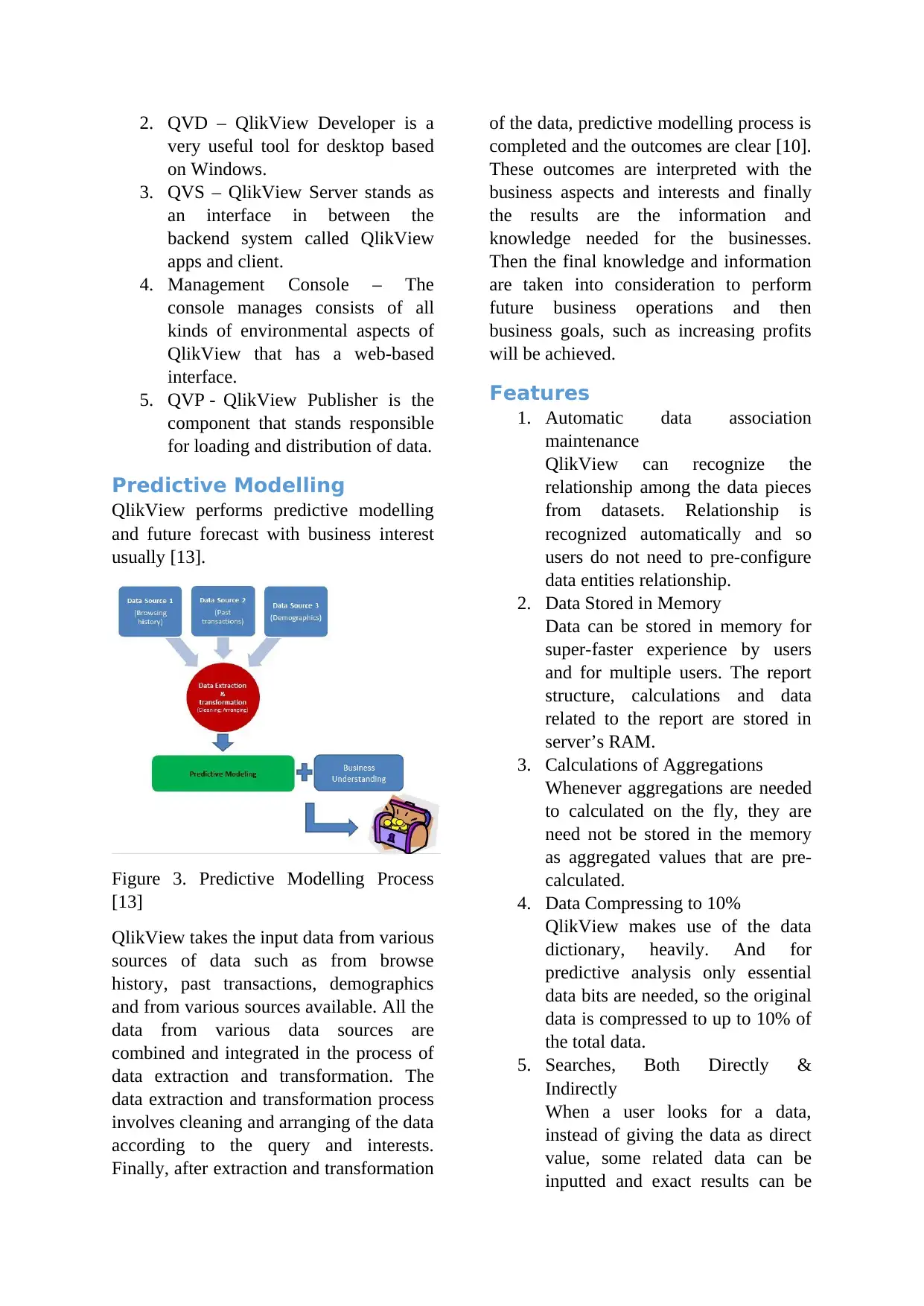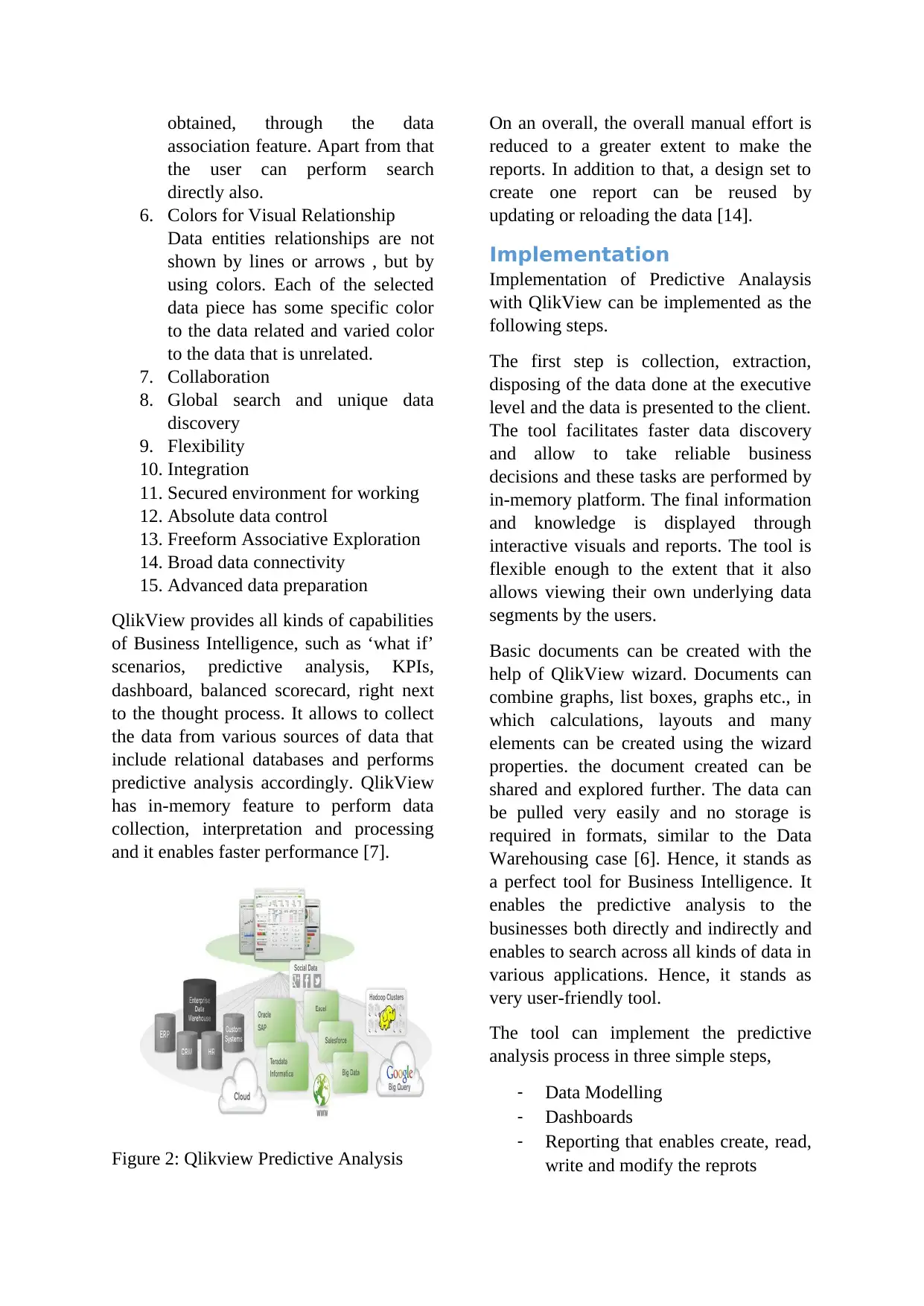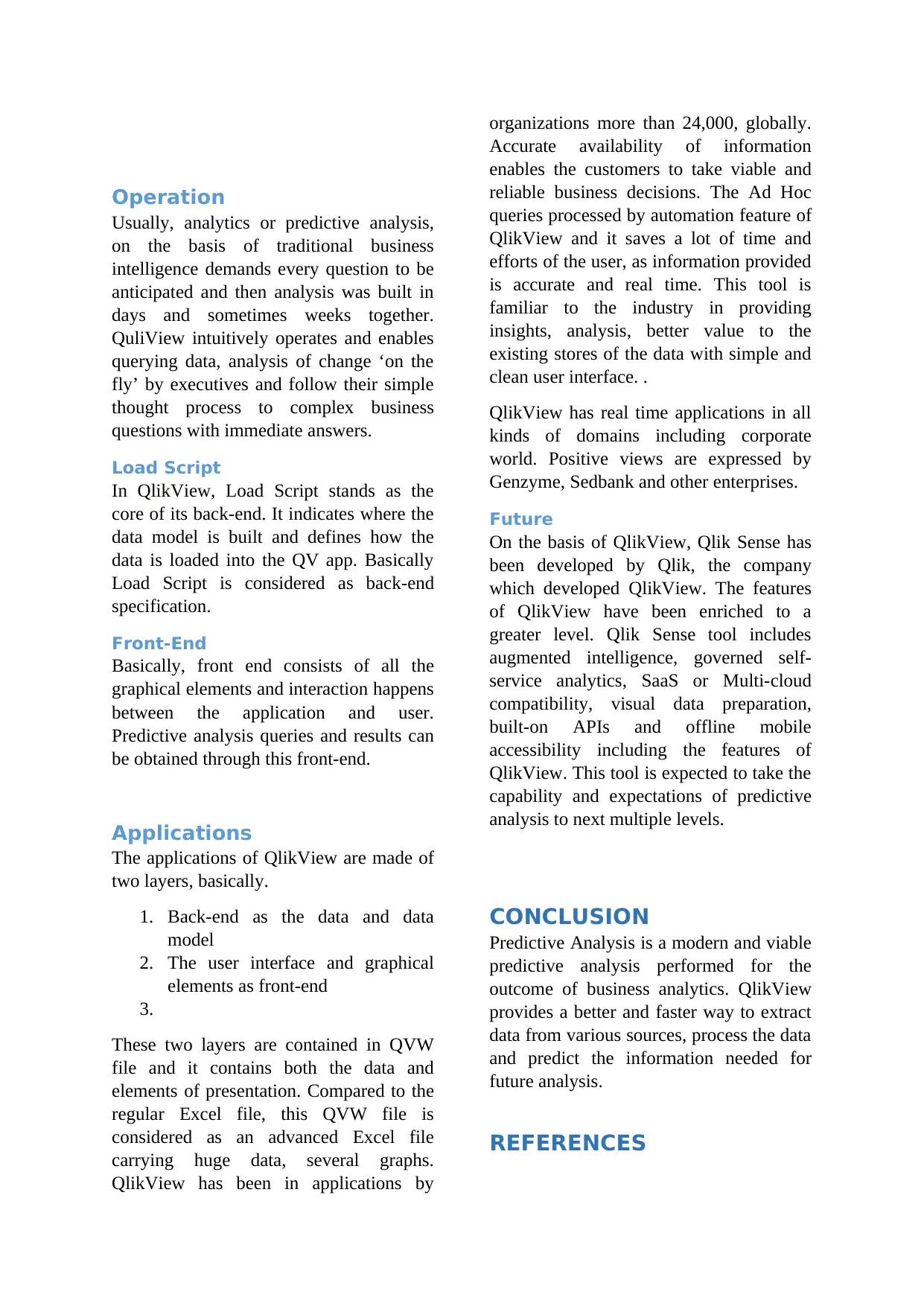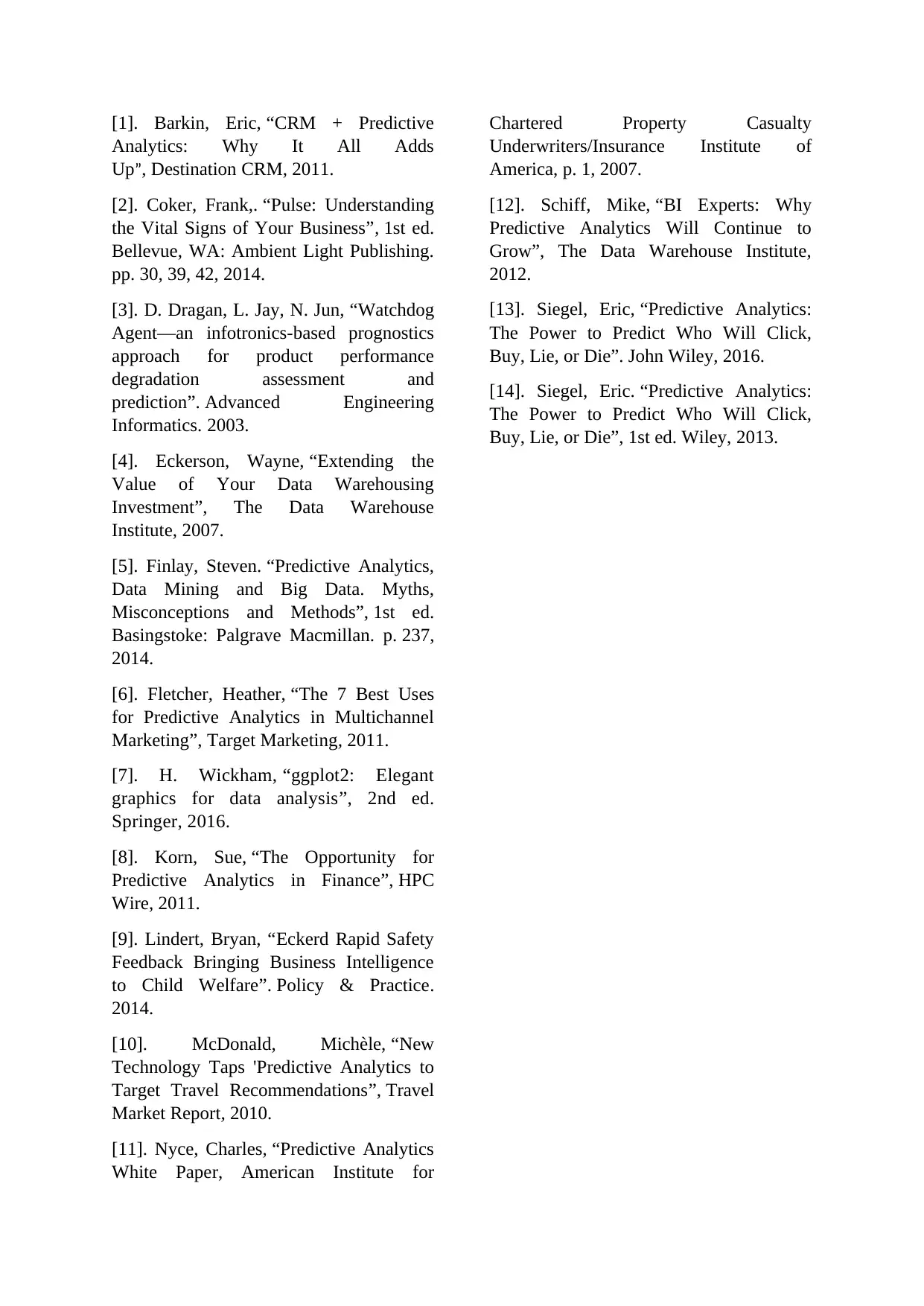QlikView: A Report on Predictive Analysis, Features & Applications
VerifiedAdded on 2023/03/31
|7
|1828
|274
Report
AI Summary
This report provides a detailed overview of predictive analysis techniques, focusing on the implementation and applications of QlikView. It begins by defining predictive analysis and outlining the predictive analysis process, followed by a discussion of various techniques including regression, artificial intelligence, and data mining. The report then delves into QlikView, tracing its history and components such as the dashboard, QVD, QVS, and management console. It elaborates on QlikView's predictive modeling process, highlighting features like automatic data association, in-memory data storage, and data compression. The implementation of predictive analysis with QlikView is described in steps, emphasizing data collection, extraction, and visualization. The report also touches on QlikView's operation, load script, front-end interface, and real-world applications across various industries. Finally, it looks at the future of QlikView with the development of Qlik Sense and concludes that QlikView offers an effective way to extract, process, and predict information for business analytics.

qwertyuiopasdfghjklzxcvbnmqw
ertyuiopasdfghjklzxcvbnmqwert
yuiopasdfghjklzxcvbnmqwertyui
opasdfghjklzxcvbnmqwertyuiopa
sdfghjklzxcvbnmqwertyuiopasdf
ghjklzxcvbnmqwertyuiopasdfghj
klzxcvbnmqwertyuiopasdfghjklz
xcvbnmqwertyuiopasdfghjklzxcv
bnmqwertyuiopasdfghjklzxcvbn
mqwertyuiopasdfghjklzxcvbnmq
wertyuiopasdfghjklzxcvbnmqwer
tyuiopasdfghjklzxcvbnmqwertyui
opasdfghjklzxcvbnmqwertyuiopa
sdfghjklzxcvbnmqwertyuiopasdf
ghjklzxcvbnmqwertyuiopasdfghj
klzxcvbnmqwertyuiopasdfghjklz
xcvbnmrtyuiopasdfghjklzxcvbnm
qwertyuiopasdfghjklzxcvbnmqw
QLIKVIEW
Statistics
5/30/2019
ertyuiopasdfghjklzxcvbnmqwert
yuiopasdfghjklzxcvbnmqwertyui
opasdfghjklzxcvbnmqwertyuiopa
sdfghjklzxcvbnmqwertyuiopasdf
ghjklzxcvbnmqwertyuiopasdfghj
klzxcvbnmqwertyuiopasdfghjklz
xcvbnmqwertyuiopasdfghjklzxcv
bnmqwertyuiopasdfghjklzxcvbn
mqwertyuiopasdfghjklzxcvbnmq
wertyuiopasdfghjklzxcvbnmqwer
tyuiopasdfghjklzxcvbnmqwertyui
opasdfghjklzxcvbnmqwertyuiopa
sdfghjklzxcvbnmqwertyuiopasdf
ghjklzxcvbnmqwertyuiopasdfghj
klzxcvbnmqwertyuiopasdfghjklz
xcvbnmrtyuiopasdfghjklzxcvbnm
qwertyuiopasdfghjklzxcvbnmqw
QLIKVIEW
Statistics
5/30/2019
Paraphrase This Document
Need a fresh take? Get an instant paraphrase of this document with our AI Paraphraser

Contents
PREDICTIVE ANALYSIS............................................................................................................................1
Predictive Analysis Process................................................................................................................1
PREDICTIVE ANALYSIS TECHNIQUES......................................................................................................1
QLIKVIEW...............................................................................................................................................2
History...............................................................................................................................................2
Components......................................................................................................................................2
Predictive Modelling..........................................................................................................................2
Features.............................................................................................................................................3
Implementation.................................................................................................................................5
Operation..........................................................................................................................................6
Load Script.....................................................................................................................................6
Front-End.......................................................................................................................................6
Applications.......................................................................................................................................6
Future............................................................................................................................................6
CONCLUSION.........................................................................................................................................7
REFERENCES..........................................................................................................................................7
PREDICTIVE ANALYSIS............................................................................................................................1
Predictive Analysis Process................................................................................................................1
PREDICTIVE ANALYSIS TECHNIQUES......................................................................................................1
QLIKVIEW...............................................................................................................................................2
History...............................................................................................................................................2
Components......................................................................................................................................2
Predictive Modelling..........................................................................................................................2
Features.............................................................................................................................................3
Implementation.................................................................................................................................5
Operation..........................................................................................................................................6
Load Script.....................................................................................................................................6
Front-End.......................................................................................................................................6
Applications.......................................................................................................................................6
Future............................................................................................................................................6
CONCLUSION.........................................................................................................................................7
REFERENCES..........................................................................................................................................7

PREDICTIVE ANALYSIS
Predictive analysis is a method of analysis
that makes predictions for unknown events
or about future on the basis of current and
historical facts. PA follows the technical
approaches to provide predictive score for
the clients to inform influence or
determine processes of organizations
pertaining across huge customers, like in
fraud detection, healthcare, credit risk
assessment, marketing, manufacturing, law
enforcement and other government
operations[1].
Predictive Analysis Process
Figure 1: Predictive Modelling Process
PREDICTIVE ANALYSIS
TECHNIQUES
Predictive analysis encompasses majorly
certain statistical techniques, regression
techniques, artificial intelligence, data
modelling, deep learning algorithms, data
mining, and machine learning techniques
to analyze on massive volumes data both
in structured and unstructured formats [2].
And predictive analysis techniques applied
in more detailed involve description,
segmentation, correlation, regression,
classification and association [3].
QLIKVIEW
Qlikview is one of the predictive anlaysis
techniques that follow linear regression
method to perform analysis. QlikView
today stands as one of the important
Business Intelligence tools that is the most
flexible and it can turn raw data into useful
knowledge, through predictive analysis. In
simple terms QlikView is an excellent
platform to transform the data to
information. Modern era of analytics has
begun with the QlikView launch and
stands as a classic analytics solution.
QlikView is built on an associative engine,
which played the role of game-changing
factor. The tool has revolutionized the way
data is used by the organizations, with
intuitive visual discovery and enabled
many more customers, from large scale to
medium scale businesses to use business
intelligence, than before.
History
QlikView was initially developed as a PC
based software and was named as “Quik
View”. The term QUIK is the acronym for
Quality, Understanding, Interaction and
Knowledge.
Components
QlikView performs predictive analysis
through the following components.
1. Dashboard – It is a platform for
report creation.
1 Proejct
definition
Data
Collection
Data Analyis
2 Statistics
Modelling
Deployment
Model
Monitoring
Predictive analysis is a method of analysis
that makes predictions for unknown events
or about future on the basis of current and
historical facts. PA follows the technical
approaches to provide predictive score for
the clients to inform influence or
determine processes of organizations
pertaining across huge customers, like in
fraud detection, healthcare, credit risk
assessment, marketing, manufacturing, law
enforcement and other government
operations[1].
Predictive Analysis Process
Figure 1: Predictive Modelling Process
PREDICTIVE ANALYSIS
TECHNIQUES
Predictive analysis encompasses majorly
certain statistical techniques, regression
techniques, artificial intelligence, data
modelling, deep learning algorithms, data
mining, and machine learning techniques
to analyze on massive volumes data both
in structured and unstructured formats [2].
And predictive analysis techniques applied
in more detailed involve description,
segmentation, correlation, regression,
classification and association [3].
QLIKVIEW
Qlikview is one of the predictive anlaysis
techniques that follow linear regression
method to perform analysis. QlikView
today stands as one of the important
Business Intelligence tools that is the most
flexible and it can turn raw data into useful
knowledge, through predictive analysis. In
simple terms QlikView is an excellent
platform to transform the data to
information. Modern era of analytics has
begun with the QlikView launch and
stands as a classic analytics solution.
QlikView is built on an associative engine,
which played the role of game-changing
factor. The tool has revolutionized the way
data is used by the organizations, with
intuitive visual discovery and enabled
many more customers, from large scale to
medium scale businesses to use business
intelligence, than before.
History
QlikView was initially developed as a PC
based software and was named as “Quik
View”. The term QUIK is the acronym for
Quality, Understanding, Interaction and
Knowledge.
Components
QlikView performs predictive analysis
through the following components.
1. Dashboard – It is a platform for
report creation.
1 Proejct
definition
Data
Collection
Data Analyis
2 Statistics
Modelling
Deployment
Model
Monitoring
⊘ This is a preview!⊘
Do you want full access?
Subscribe today to unlock all pages.

Trusted by 1+ million students worldwide

2. QVD – QlikView Developer is a
very useful tool for desktop based
on Windows.
3. QVS – QlikView Server stands as
an interface in between the
backend system called QlikView
apps and client.
4. Management Console – The
console manages consists of all
kinds of environmental aspects of
QlikView that has a web-based
interface.
5. QVP - QlikView Publisher is the
component that stands responsible
for loading and distribution of data.
Predictive Modelling
QlikView performs predictive modelling
and future forecast with business interest
usually [13].
Figure 3. Predictive Modelling Process
[13]
QlikView takes the input data from various
sources of data such as from browse
history, past transactions, demographics
and from various sources available. All the
data from various data sources are
combined and integrated in the process of
data extraction and transformation. The
data extraction and transformation process
involves cleaning and arranging of the data
according to the query and interests.
Finally, after extraction and transformation
of the data, predictive modelling process is
completed and the outcomes are clear [10].
These outcomes are interpreted with the
business aspects and interests and finally
the results are the information and
knowledge needed for the businesses.
Then the final knowledge and information
are taken into consideration to perform
future business operations and then
business goals, such as increasing profits
will be achieved.
Features
1. Automatic data association
maintenance
QlikView can recognize the
relationship among the data pieces
from datasets. Relationship is
recognized automatically and so
users do not need to pre-configure
data entities relationship.
2. Data Stored in Memory
Data can be stored in memory for
super-faster experience by users
and for multiple users. The report
structure, calculations and data
related to the report are stored in
server’s RAM.
3. Calculations of Aggregations
Whenever aggregations are needed
to calculated on the fly, they are
need not be stored in the memory
as aggregated values that are pre-
calculated.
4. Data Compressing to 10%
QlikView makes use of the data
dictionary, heavily. And for
predictive analysis only essential
data bits are needed, so the original
data is compressed to up to 10% of
the total data.
5. Searches, Both Directly &
Indirectly
When a user looks for a data,
instead of giving the data as direct
value, some related data can be
inputted and exact results can be
very useful tool for desktop based
on Windows.
3. QVS – QlikView Server stands as
an interface in between the
backend system called QlikView
apps and client.
4. Management Console – The
console manages consists of all
kinds of environmental aspects of
QlikView that has a web-based
interface.
5. QVP - QlikView Publisher is the
component that stands responsible
for loading and distribution of data.
Predictive Modelling
QlikView performs predictive modelling
and future forecast with business interest
usually [13].
Figure 3. Predictive Modelling Process
[13]
QlikView takes the input data from various
sources of data such as from browse
history, past transactions, demographics
and from various sources available. All the
data from various data sources are
combined and integrated in the process of
data extraction and transformation. The
data extraction and transformation process
involves cleaning and arranging of the data
according to the query and interests.
Finally, after extraction and transformation
of the data, predictive modelling process is
completed and the outcomes are clear [10].
These outcomes are interpreted with the
business aspects and interests and finally
the results are the information and
knowledge needed for the businesses.
Then the final knowledge and information
are taken into consideration to perform
future business operations and then
business goals, such as increasing profits
will be achieved.
Features
1. Automatic data association
maintenance
QlikView can recognize the
relationship among the data pieces
from datasets. Relationship is
recognized automatically and so
users do not need to pre-configure
data entities relationship.
2. Data Stored in Memory
Data can be stored in memory for
super-faster experience by users
and for multiple users. The report
structure, calculations and data
related to the report are stored in
server’s RAM.
3. Calculations of Aggregations
Whenever aggregations are needed
to calculated on the fly, they are
need not be stored in the memory
as aggregated values that are pre-
calculated.
4. Data Compressing to 10%
QlikView makes use of the data
dictionary, heavily. And for
predictive analysis only essential
data bits are needed, so the original
data is compressed to up to 10% of
the total data.
5. Searches, Both Directly &
Indirectly
When a user looks for a data,
instead of giving the data as direct
value, some related data can be
inputted and exact results can be
Paraphrase This Document
Need a fresh take? Get an instant paraphrase of this document with our AI Paraphraser

obtained, through the data
association feature. Apart from that
the user can perform search
directly also.
6. Colors for Visual Relationship
Data entities relationships are not
shown by lines or arrows , but by
using colors. Each of the selected
data piece has some specific color
to the data related and varied color
to the data that is unrelated.
7. Collaboration
8. Global search and unique data
discovery
9. Flexibility
10. Integration
11. Secured environment for working
12. Absolute data control
13. Freeform Associative Exploration
14. Broad data connectivity
15. Advanced data preparation
QlikView provides all kinds of capabilities
of Business Intelligence, such as ‘what if’
scenarios, predictive analysis, KPIs,
dashboard, balanced scorecard, right next
to the thought process. It allows to collect
the data from various sources of data that
include relational databases and performs
predictive analysis accordingly. QlikView
has in-memory feature to perform data
collection, interpretation and processing
and it enables faster performance [7].
Figure 2: Qlikview Predictive Analysis
On an overall, the overall manual effort is
reduced to a greater extent to make the
reports. In addition to that, a design set to
create one report can be reused by
updating or reloading the data [14].
Implementation
Implementation of Predictive Analaysis
with QlikView can be implemented as the
following steps.
The first step is collection, extraction,
disposing of the data done at the executive
level and the data is presented to the client.
The tool facilitates faster data discovery
and allow to take reliable business
decisions and these tasks are performed by
in-memory platform. The final information
and knowledge is displayed through
interactive visuals and reports. The tool is
flexible enough to the extent that it also
allows viewing their own underlying data
segments by the users.
Basic documents can be created with the
help of QlikView wizard. Documents can
combine graphs, list boxes, graphs etc., in
which calculations, layouts and many
elements can be created using the wizard
properties. the document created can be
shared and explored further. The data can
be pulled very easily and no storage is
required in formats, similar to the Data
Warehousing case [6]. Hence, it stands as
a perfect tool for Business Intelligence. It
enables the predictive analysis to the
businesses both directly and indirectly and
enables to search across all kinds of data in
various applications. Hence, it stands as
very user-friendly tool.
The tool can implement the predictive
analysis process in three simple steps,
- Data Modelling
- Dashboards
- Reporting that enables create, read,
write and modify the reprots
association feature. Apart from that
the user can perform search
directly also.
6. Colors for Visual Relationship
Data entities relationships are not
shown by lines or arrows , but by
using colors. Each of the selected
data piece has some specific color
to the data related and varied color
to the data that is unrelated.
7. Collaboration
8. Global search and unique data
discovery
9. Flexibility
10. Integration
11. Secured environment for working
12. Absolute data control
13. Freeform Associative Exploration
14. Broad data connectivity
15. Advanced data preparation
QlikView provides all kinds of capabilities
of Business Intelligence, such as ‘what if’
scenarios, predictive analysis, KPIs,
dashboard, balanced scorecard, right next
to the thought process. It allows to collect
the data from various sources of data that
include relational databases and performs
predictive analysis accordingly. QlikView
has in-memory feature to perform data
collection, interpretation and processing
and it enables faster performance [7].
Figure 2: Qlikview Predictive Analysis
On an overall, the overall manual effort is
reduced to a greater extent to make the
reports. In addition to that, a design set to
create one report can be reused by
updating or reloading the data [14].
Implementation
Implementation of Predictive Analaysis
with QlikView can be implemented as the
following steps.
The first step is collection, extraction,
disposing of the data done at the executive
level and the data is presented to the client.
The tool facilitates faster data discovery
and allow to take reliable business
decisions and these tasks are performed by
in-memory platform. The final information
and knowledge is displayed through
interactive visuals and reports. The tool is
flexible enough to the extent that it also
allows viewing their own underlying data
segments by the users.
Basic documents can be created with the
help of QlikView wizard. Documents can
combine graphs, list boxes, graphs etc., in
which calculations, layouts and many
elements can be created using the wizard
properties. the document created can be
shared and explored further. The data can
be pulled very easily and no storage is
required in formats, similar to the Data
Warehousing case [6]. Hence, it stands as
a perfect tool for Business Intelligence. It
enables the predictive analysis to the
businesses both directly and indirectly and
enables to search across all kinds of data in
various applications. Hence, it stands as
very user-friendly tool.
The tool can implement the predictive
analysis process in three simple steps,
- Data Modelling
- Dashboards
- Reporting that enables create, read,
write and modify the reprots

Operation
Usually, analytics or predictive analysis,
on the basis of traditional business
intelligence demands every question to be
anticipated and then analysis was built in
days and sometimes weeks together.
QuliView intuitively operates and enables
querying data, analysis of change ‘on the
fly’ by executives and follow their simple
thought process to complex business
questions with immediate answers.
Load Script
In QlikView, Load Script stands as the
core of its back-end. It indicates where the
data model is built and defines how the
data is loaded into the QV app. Basically
Load Script is considered as back-end
specification.
Front-End
Basically, front end consists of all the
graphical elements and interaction happens
between the application and user.
Predictive analysis queries and results can
be obtained through this front-end.
Applications
The applications of QlikView are made of
two layers, basically.
1. Back-end as the data and data
model
2. The user interface and graphical
elements as front-end
3.
These two layers are contained in QVW
file and it contains both the data and
elements of presentation. Compared to the
regular Excel file, this QVW file is
considered as an advanced Excel file
carrying huge data, several graphs.
QlikView has been in applications by
organizations more than 24,000, globally.
Accurate availability of information
enables the customers to take viable and
reliable business decisions. The Ad Hoc
queries processed by automation feature of
QlikView and it saves a lot of time and
efforts of the user, as information provided
is accurate and real time. This tool is
familiar to the industry in providing
insights, analysis, better value to the
existing stores of the data with simple and
clean user interface. .
QlikView has real time applications in all
kinds of domains including corporate
world. Positive views are expressed by
Genzyme, Sedbank and other enterprises.
Future
On the basis of QlikView, Qlik Sense has
been developed by Qlik, the company
which developed QlikView. The features
of QlikView have been enriched to a
greater level. Qlik Sense tool includes
augmented intelligence, governed self-
service analytics, SaaS or Multi-cloud
compatibility, visual data preparation,
built-on APIs and offline mobile
accessibility including the features of
QlikView. This tool is expected to take the
capability and expectations of predictive
analysis to next multiple levels.
CONCLUSION
Predictive Analysis is a modern and viable
predictive analysis performed for the
outcome of business analytics. QlikView
provides a better and faster way to extract
data from various sources, process the data
and predict the information needed for
future analysis.
REFERENCES
Usually, analytics or predictive analysis,
on the basis of traditional business
intelligence demands every question to be
anticipated and then analysis was built in
days and sometimes weeks together.
QuliView intuitively operates and enables
querying data, analysis of change ‘on the
fly’ by executives and follow their simple
thought process to complex business
questions with immediate answers.
Load Script
In QlikView, Load Script stands as the
core of its back-end. It indicates where the
data model is built and defines how the
data is loaded into the QV app. Basically
Load Script is considered as back-end
specification.
Front-End
Basically, front end consists of all the
graphical elements and interaction happens
between the application and user.
Predictive analysis queries and results can
be obtained through this front-end.
Applications
The applications of QlikView are made of
two layers, basically.
1. Back-end as the data and data
model
2. The user interface and graphical
elements as front-end
3.
These two layers are contained in QVW
file and it contains both the data and
elements of presentation. Compared to the
regular Excel file, this QVW file is
considered as an advanced Excel file
carrying huge data, several graphs.
QlikView has been in applications by
organizations more than 24,000, globally.
Accurate availability of information
enables the customers to take viable and
reliable business decisions. The Ad Hoc
queries processed by automation feature of
QlikView and it saves a lot of time and
efforts of the user, as information provided
is accurate and real time. This tool is
familiar to the industry in providing
insights, analysis, better value to the
existing stores of the data with simple and
clean user interface. .
QlikView has real time applications in all
kinds of domains including corporate
world. Positive views are expressed by
Genzyme, Sedbank and other enterprises.
Future
On the basis of QlikView, Qlik Sense has
been developed by Qlik, the company
which developed QlikView. The features
of QlikView have been enriched to a
greater level. Qlik Sense tool includes
augmented intelligence, governed self-
service analytics, SaaS or Multi-cloud
compatibility, visual data preparation,
built-on APIs and offline mobile
accessibility including the features of
QlikView. This tool is expected to take the
capability and expectations of predictive
analysis to next multiple levels.
CONCLUSION
Predictive Analysis is a modern and viable
predictive analysis performed for the
outcome of business analytics. QlikView
provides a better and faster way to extract
data from various sources, process the data
and predict the information needed for
future analysis.
REFERENCES
⊘ This is a preview!⊘
Do you want full access?
Subscribe today to unlock all pages.

Trusted by 1+ million students worldwide

[1]. Barkin, Eric, “CRM + Predictive
Analytics: Why It All Adds
Up”, Destination CRM, 2011.
[2]. Coker, Frank,. “Pulse: Understanding
the Vital Signs of Your Business”, 1st ed.
Bellevue, WA: Ambient Light Publishing.
pp. 30, 39, 42, 2014.
[3]. D. Dragan, L. Jay, N. Jun, “Watchdog
Agent—an infotronics-based prognostics
approach for product performance
degradation assessment and
prediction”. Advanced Engineering
Informatics. 2003.
[4]. Eckerson, Wayne, “Extending the
Value of Your Data Warehousing
Investment”, The Data Warehouse
Institute, 2007.
[5]. Finlay, Steven. “Predictive Analytics,
Data Mining and Big Data. Myths,
Misconceptions and Methods”, 1st ed.
Basingstoke: Palgrave Macmillan. p. 237,
2014.
[6]. Fletcher, Heather, “The 7 Best Uses
for Predictive Analytics in Multichannel
Marketing”, Target Marketing, 2011.
[7]. H. Wickham, “ggplot2: Elegant
graphics for data analysis”, 2nd ed.
Springer, 2016.
[8]. Korn, Sue, “The Opportunity for
Predictive Analytics in Finance”, HPC
Wire, 2011.
[9]. Lindert, Bryan, “Eckerd Rapid Safety
Feedback Bringing Business Intelligence
to Child Welfare”. Policy & Practice.
2014.
[10]. McDonald, Michèle, “New
Technology Taps 'Predictive Analytics to
Target Travel Recommendations”, Travel
Market Report, 2010.
[11]. Nyce, Charles, “Predictive Analytics
White Paper, American Institute for
Chartered Property Casualty
Underwriters/Insurance Institute of
America, p. 1, 2007.
[12]. Schiff, Mike, “BI Experts: Why
Predictive Analytics Will Continue to
Grow”, The Data Warehouse Institute,
2012.
[13]. Siegel, Eric, “Predictive Analytics:
The Power to Predict Who Will Click,
Buy, Lie, or Die”. John Wiley, 2016.
[14]. Siegel, Eric. “Predictive Analytics:
The Power to Predict Who Will Click,
Buy, Lie, or Die”, 1st ed. Wiley, 2013.
Analytics: Why It All Adds
Up”, Destination CRM, 2011.
[2]. Coker, Frank,. “Pulse: Understanding
the Vital Signs of Your Business”, 1st ed.
Bellevue, WA: Ambient Light Publishing.
pp. 30, 39, 42, 2014.
[3]. D. Dragan, L. Jay, N. Jun, “Watchdog
Agent—an infotronics-based prognostics
approach for product performance
degradation assessment and
prediction”. Advanced Engineering
Informatics. 2003.
[4]. Eckerson, Wayne, “Extending the
Value of Your Data Warehousing
Investment”, The Data Warehouse
Institute, 2007.
[5]. Finlay, Steven. “Predictive Analytics,
Data Mining and Big Data. Myths,
Misconceptions and Methods”, 1st ed.
Basingstoke: Palgrave Macmillan. p. 237,
2014.
[6]. Fletcher, Heather, “The 7 Best Uses
for Predictive Analytics in Multichannel
Marketing”, Target Marketing, 2011.
[7]. H. Wickham, “ggplot2: Elegant
graphics for data analysis”, 2nd ed.
Springer, 2016.
[8]. Korn, Sue, “The Opportunity for
Predictive Analytics in Finance”, HPC
Wire, 2011.
[9]. Lindert, Bryan, “Eckerd Rapid Safety
Feedback Bringing Business Intelligence
to Child Welfare”. Policy & Practice.
2014.
[10]. McDonald, Michèle, “New
Technology Taps 'Predictive Analytics to
Target Travel Recommendations”, Travel
Market Report, 2010.
[11]. Nyce, Charles, “Predictive Analytics
White Paper, American Institute for
Chartered Property Casualty
Underwriters/Insurance Institute of
America, p. 1, 2007.
[12]. Schiff, Mike, “BI Experts: Why
Predictive Analytics Will Continue to
Grow”, The Data Warehouse Institute,
2012.
[13]. Siegel, Eric, “Predictive Analytics:
The Power to Predict Who Will Click,
Buy, Lie, or Die”. John Wiley, 2016.
[14]. Siegel, Eric. “Predictive Analytics:
The Power to Predict Who Will Click,
Buy, Lie, or Die”, 1st ed. Wiley, 2013.
1 out of 7
Related Documents
Your All-in-One AI-Powered Toolkit for Academic Success.
+13062052269
info@desklib.com
Available 24*7 on WhatsApp / Email
![[object Object]](/_next/static/media/star-bottom.7253800d.svg)
Unlock your academic potential
Copyright © 2020–2025 A2Z Services. All Rights Reserved. Developed and managed by ZUCOL.





